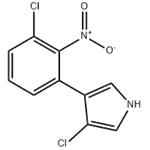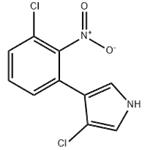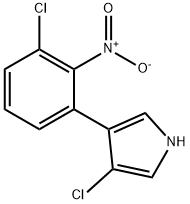- PYRROLNITRIN
-

- $0.00 / 1KG
-
2024-07-18
- CAS:1018-71-9
- Min. Order: 1KG
- Purity: 99.0%
- Supply Ability: 1000KG
- PYRROLNITRIN
-

- $8.00 / 1kg
-
2024-03-29
- CAS:1018-71-9
- Min. Order: 1kg
- Purity: 99%
- Supply Ability: g-kg-tons, free sample is available
|
| | PYRROLNITRIN Basic information |
| Product Name: | PYRROLNITRIN | | Synonyms: | 3-chloro-4-(2’-nitro-3’-chlorophenyl)pyrrole;3-chloro-4-(3-chloro-2-nitrophenyl)-pyrrol;nsc-107654;pyroace;pyrollnitrin;PYRROLE,3-CHLORO-4-(3-CHLORO-2-NITROPHENYL)-;52230;A-10338 | | CAS: | 1018-71-9 | | MF: | C10H6Cl2N2O2 | | MW: | 257.07 | | EINECS: | 213-812-7 | | Product Categories: | | | Mol File: | 1018-71-9.mol |  |
| | PYRROLNITRIN Chemical Properties |
| Melting point | 124.5° | | Boiling point | 410.5±45.0 °C(Predicted) | | density | 1.5834 (rough estimate) | | refractive index | 1.6100 (estimate) | | storage temp. | Store at -20°C | | solubility | DMSO: 10 mM | | form | A solid | | pka | 14.28±0.50(Predicted) | | color | Light green to green |
| Toxicity | LD50 in rats, rabbits (mg/kg): 68, 105 i.p. (Nishida) |
| | PYRROLNITRIN Usage And Synthesis |
| Description | Pyrrolnitrin, isolated from Pseudomonas
species, is highly active against fungi,
particularly trichophyte species. | | Uses | Antifungal. | | Uses | Pyrrolnitrin from Pseudomonas cepacia has been used as a standard in the detection of pyrrolnitrin in Serratia marcescens cell culture extract. | | Definition | ChEBI: A member of the class of pyrroles carrying chloro and 3-chloro-2-nitrophenyl substituents at positions 3 and 4 respectively. | | Origin | Pyrrolnitrin was found in the cells of Pseudomonas pyrrocinia grownin a medium containing a high concentration of inorganic phosphate.It was discovered by Arima of the University of Tokyo in collaboration with Fujisawa Pharmaceutical Industries Co. in 1965. | | Biological Activity |
Pyrrolnitrin shows strong activity against a variety of fungi and weak activity against grampositive bacteria.
| | Biochem/physiol Actions | Pyrrolnitrin blocks the terminal electron transport between succinate or reduced NADH and coenzyme Q. In mitochondria preparations of S. cerevisiae, the antibiotic inhibited succinate oxidase, NADH oxidase, succinate cythochrome C reductase, and NADH-cytochrome C reductase. Pyrrolnitrin is involved in many cellular processes such as oxidative stress, electron transport, DNA and RNA synthesis. |
| | PYRROLNITRIN Preparation Products And Raw materials |
|